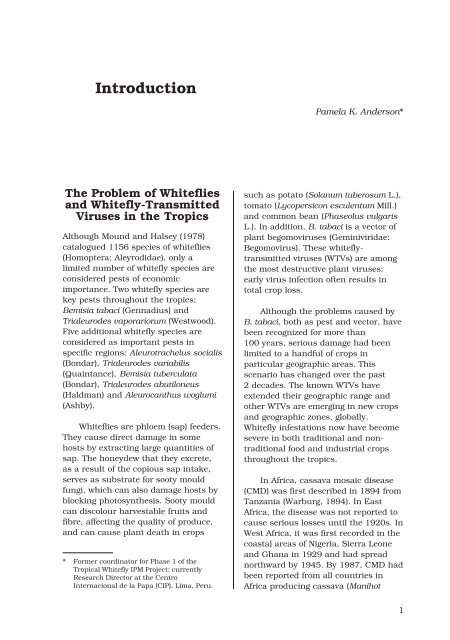Whitefly and whitefly-borne viruses in the tropics : Building a ... - cgiar
Whitefly and whitefly-borne viruses in the tropics : Building a ... - cgiar
Whitefly and whitefly-borne viruses in the tropics : Building a ... - cgiar
Create successful ePaper yourself
Turn your PDF publications into a flip-book with our unique Google optimized e-Paper software.
Introduction<br />
Introduction<br />
The Problem of Whiteflies<br />
<strong>and</strong> <strong>Whitefly</strong>-Transmitted<br />
Viruses <strong>in</strong> <strong>the</strong> Tropics<br />
Although Mound <strong>and</strong> Halsey (1978)<br />
catalogued 1156 species of whiteflies<br />
(Homoptera: Aleyrodidae), only a<br />
limited number of <strong>whitefly</strong> species are<br />
considered pests of economic<br />
importance. Two <strong>whitefly</strong> species are<br />
key pests throughout <strong>the</strong> <strong>tropics</strong>:<br />
Bemisia tabaci (Gennadius) <strong>and</strong><br />
Trialeurodes vaporariorum (Westwood).<br />
Five additional <strong>whitefly</strong> species are<br />
considered as important pests <strong>in</strong><br />
specific regions: Aleurotrachelus socialis<br />
(Bondar), Trialeurodes variabilis<br />
(Qua<strong>in</strong>tance), Bemisia tuberculata<br />
(Bondar), Trialeurodes abutiloneus<br />
(Haldman) <strong>and</strong> Aleurocanthus woglumi<br />
(Ashby).<br />
Whiteflies are phloem (sap) feeders.<br />
They cause direct damage <strong>in</strong> some<br />
hosts by extract<strong>in</strong>g large quantities of<br />
sap. The honeydew that <strong>the</strong>y excrete,<br />
as a result of <strong>the</strong> copious sap <strong>in</strong>take,<br />
serves as substrate for sooty mould<br />
fungi, which can also damage hosts by<br />
block<strong>in</strong>g photosyn<strong>the</strong>sis. Sooty mould<br />
can discolour harvestable fruits <strong>and</strong><br />
fibre, affect<strong>in</strong>g <strong>the</strong> quality of produce,<br />
<strong>and</strong> can cause plant death <strong>in</strong> crops<br />
* Former coord<strong>in</strong>ator for Phase 1 of <strong>the</strong><br />
Tropical <strong>Whitefly</strong> IPM Project; currently<br />
Research Director at <strong>the</strong> Centro<br />
Internacional de la Papa (CIP), Lima, Peru.<br />
Pamela K. Anderson*<br />
such as potato (Solanum tuberosum L.),<br />
tomato (Lycopersicon esculentum Mill.)<br />
<strong>and</strong> common bean (Phaseolus vulgaris<br />
L.). In addition, B. tabaci is a vector of<br />
plant begomo<strong>viruses</strong> (Gem<strong>in</strong>iviridae:<br />
Begomovirus). These <strong>whitefly</strong>transmitted<br />
<strong>viruses</strong> (WTVs) are among<br />
<strong>the</strong> most destructive plant <strong>viruses</strong>;<br />
early virus <strong>in</strong>fection often results <strong>in</strong><br />
total crop loss.<br />
Although <strong>the</strong> problems caused by<br />
B. tabaci, both as pest <strong>and</strong> vector, have<br />
been recognized for more than<br />
100 years, serious damage had been<br />
limited to a h<strong>and</strong>ful of crops <strong>in</strong><br />
particular geographic areas. This<br />
scenario has changed over <strong>the</strong> past<br />
2 decades. The known WTVs have<br />
extended <strong>the</strong>ir geographic range <strong>and</strong><br />
o<strong>the</strong>r WTVs are emerg<strong>in</strong>g <strong>in</strong> new crops<br />
<strong>and</strong> geographic zones, globally.<br />
<strong>Whitefly</strong> <strong>in</strong>festations now have become<br />
severe <strong>in</strong> both traditional <strong>and</strong> nontraditional<br />
food <strong>and</strong> <strong>in</strong>dustrial crops<br />
throughout <strong>the</strong> <strong>tropics</strong>.<br />
In Africa, cassava mosaic disease<br />
(CMD) was first described <strong>in</strong> 1894 from<br />
Tanzania (Warburg, 1894). In East<br />
Africa, <strong>the</strong> disease was not reported to<br />
cause serious losses until <strong>the</strong> 1920s. In<br />
West Africa, it was first recorded <strong>in</strong> <strong>the</strong><br />
coastal areas of Nigeria, Sierra Leone<br />
<strong>and</strong> Ghana <strong>in</strong> 1929 <strong>and</strong> had spread<br />
northward by 1945. By 1987, CMD had<br />
been reported from all countries <strong>in</strong><br />
Africa produc<strong>in</strong>g cassava (Manihot<br />
1
















